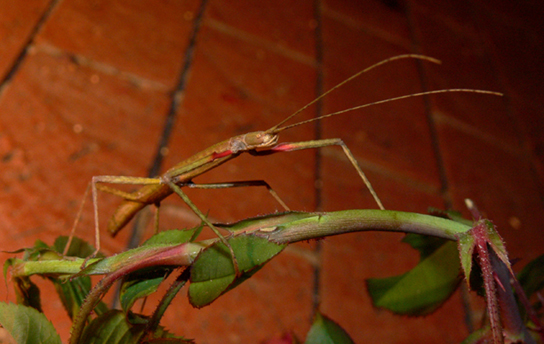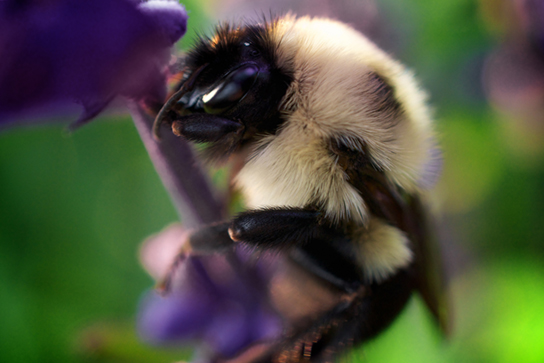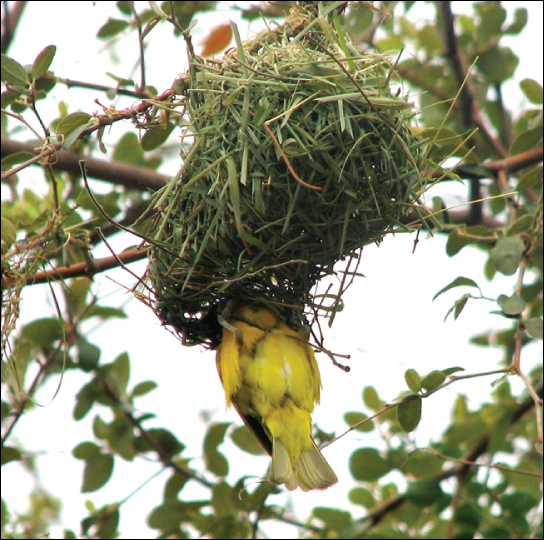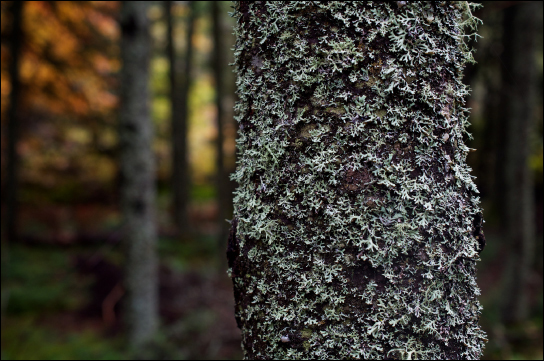45.6: אקולוגיה קהילתית
- Page ID
- 206285
מיומנויות לפיתוח
- דון במחזור הטורף-טרף
- תן דוגמאות להגנות מפני טריפה ואוכלי עשב
- תאר את עקרון ההדרה התחרותי
- תן דוגמאות ליחסים סימביוטיים בין מינים
- תאר את מבנה הקהילה ואת הירושה
אוכלוסיות לעיתים רחוקות, אם בכלל, חיות במנותק מאוכלוסיות של מינים אחרים. ברוב המקרים, מינים רבים חולקים בית גידול. האינטראקציות בין אוכלוסיות אלה ממלאות תפקיד מרכזי בוויסות גידול האוכלוסייה והשפע. כל האוכלוסיות התופסות את אותו בית גידול יוצרות קהילה: אוכלוסיות המאכלסות אזור מסוים בו זמנית. מספר המינים התופסים את אותו בית גידול והשפע היחסי שלהם ידוע כמגוון מינים. אזורים עם מגוון נמוך, כמו הקרחונים של אנטארקטיקה, עדיין מכילים מגוון רחב של יצורים חיים, ואילו המגוון של יערות הגשם הטרופיים הוא כה גדול עד שלא ניתן לספור אותו. אקולוגיה נחקרת ברמה הקהילתית כדי להבין כיצד מינים מתקשרים זה עם זה ומתחרים על אותם משאבים.
טריפה ואוכלי עשב
אולי הדוגמה הקלאסית לאינטראקציה בין מינים היא טרף: ציד טרף על ידי הטורף שלו. תוכניות טבע בטלוויזיה מדגישות את הדרמה של אורגניזם חי אחד שהורג אחר. אוכלוסיות טורפים וטרף בקהילה אינן קבועות לאורך זמן: ברוב המקרים הן משתנות במחזורים שנראים קשורים זה לזה. הדוגמה המצוטטת ביותר לדינמיקה של טורף-טרף נראית ברכיבה על אופניים של הלינקס (טורף) וארנבת השלג (טרף), תוך שימוש בנתוני לכידה בני כמעט 200 שנה מיערות צפון אמריקה (איור). \(\PageIndex{1}\) מחזור זה של טורף וטרף נמשך כעשר שנים, כאשר אוכלוסיית הטורפים בפיגור 1-2 שנים מזו של אוכלוסיית הטרף. ככל שמספר הארנבות גדל, יש יותר מזון זמין עבור הלינקס, מה שמאפשר גם לאוכלוסיית הלינקס לגדול. אולם כאשר אוכלוסיית הלינקס גדלה לרמת סף, הם הורגים כל כך הרבה ארנבות שאוכלוסיית הארנבות מתחילה לרדת, ואחריה ירידה באוכלוסיית הלינקס בגלל מחסור במזון. כאשר אוכלוסיית הלינקס נמוכה, גודל אוכלוסיית הארנבות מתחיל לגדול עקב, לפחות בחלקו, מלחץ טריפה נמוך, שמתחיל את המחזור מחדש.

הרעיון שמחזור האוכלוסייה של שני המינים נשלט כולו על ידי מודלים של טריפה מוטל בספק. מחקרים עדכניים יותר הצביעו על גורמים בלתי מוגדרים תלויי צפיפות כחשובים ברכיבה על אופניים, בנוסף לטריפה. אפשרות אחת היא שהרכיבה על אופניים טבועה באוכלוסיית הארנבות עקב השפעות תלויות צפיפות כגון פוריות נמוכה יותר (לחץ אימהי) הנגרמת על ידי צפיפות כאשר אוכלוסיית הארנבות צפופה מדי. רכיבה על אופניים של הארנבת תגרום לרכיבה על אופניים של הלינקס מכיוון שזהו מקור המזון העיקרי של הלינקס. ככל שאנו לומדים יותר קהילות, כך אנו מוצאים יותר מורכבות, מה שמאפשר לאקולוגים להפיק מודלים מדויקים ומתוחכמים יותר של דינמיקת האוכלוסייה.
אוכלי עשב מתאר את צריכת הצמחים על ידי חרקים ובעלי חיים אחרים, וזהו קשר בין-ספציפי נוסף המשפיע על אוכלוסיות. בניגוד לבעלי חיים, רוב הצמחים אינם יכולים לעקוף טורפים או להשתמש בחיקוי כדי להסתתר מבעלי חיים רעבים. צמחים מסוימים פיתחו מנגנונים להגנה מפני אוכלי עשב. מינים אחרים פיתחו מערכות יחסים הדדיות; לדוגמה, אוכלי עשב מספקים מנגנון של חלוקת זרעים המסייע ברביית צמחים.
מנגנוני הגנה מפני טריפה ואוכלי עשב
על חקר הקהילות לקחת בחשבון כוחות אבולוציוניים הפועלים על בני האוכלוסיות השונות הכלולות בתוכו. המינים אינם סטטיים, אלא משתנים אט אט ומסתגלים לסביבתם על ידי ברירה טבעית וכוחות אבולוציוניים אחרים. מינים פיתחו מנגנונים רבים כדי להימלט מטריפה ואוכלי עשב. הגנות אלה עשויות להיות מכניות, כימיות, פיזיות או התנהגותיות.
הגנות מכניות, כמו הימצאות קוצים על צמחים או הקליפה הקשה על צבים, מרתיעות טריפת בעלי חיים ואוכלי עשב על ידי גרימת כאב פיזי לטורף או על ידי מניעה פיזית של הטורף להיות מסוגל לאכול את הטרף. הגנות כימיות מיוצרות על ידי בעלי חיים רבים כמו גם צמחים, כמו כפפת השועל שהיא רעילה ביותר בעת אכילה. האיור \(\PageIndex{2}\) מציג את ההגנות של כמה אורגניזמים מפני טריפה ואוכלי עשב.

מינים רבים משתמשים בצורת גופם ובצבעם כדי להימנע מגילוי על ידי טורפים. מקל ההליכה הטרופי הוא חרק בעל צבע וצורת גוף של זרד מה שמקשה מאוד על ראייתו כשהוא נייח על רקע זרדים אמיתיים (איור \(\PageIndex{3}\) א). בדוגמה אחרת, הזיקית יכולה לשנות את צבעה כך שתתאים לסביבתה (איור \(\PageIndex{3}\) ב). שתי אלה הן דוגמאות להסוואה, או הימנעות מגילוי על ידי מיזוג עם הרקע.


מינים מסוימים משתמשים בצבע כדרך להזהיר טורפים שהם לא טובים לאכילה. לדוגמה, לזחל עש הקינבר, לקרפדת כרס האש ולמינים רבים של חיפושית יש צבעים עזים המזהירים מפני טעם רע, נוכחות של כימיקל רעיל ו/או יכולת לעקוץ או לנשוך, בהתאמה. טורפים שמתעלמים מצבע זה ואוכלים את האורגניזמים יחוו את טעמם הלא נעים או נוכחותם של כימיקלים רעילים וילמדו לא לאכול אותם בעתיד. סוג זה של מנגנון הגנה נקרא צבע אפוזמטי, או צבע אזהרה (איור\(\PageIndex{4}\)).

בעוד שחלק מהטורפים לומדים להימנע מאכילת טרף פוטנציאלי מסוים בגלל צבעם, מינים אחרים פיתחו מנגנונים לחקות צבע זה כדי להימנע מאכילה, למרות שהם עצמם לא יכולים להיות לא נעימים לאכילה או מכילים כימיקלים רעילים. בחיקוי בטסיאני, מין לא מזיק מחקה את צבע האזהרה של מזיק. בהנחה שהם חולקים את אותם טורפים, הצבע הזה מגן על המזיקים, למרות שאין להם אותה רמה של הגנה פיזית או כימית מפני טריפה כמו האורגניזם שהם מחקים. מיני חרקים רבים מחקים את צבעם של צרעות או דבורים, שהם חרקים עוקצים וארסיים, ובכך מרתיעים את הטריפה (איור). \(\PageIndex{5}\)


בחיקוי מולריאני, מינים מרובים חולקים את אותו צבע אזהרה, אך לכולם יש למעשה הגנות. האיור \(\PageIndex{6}\) מציג מגוון פרפרים בעלי טעם רע עם צבע דומה. בחיקוי אמסליאני/מרטנסיאני, טרף קטלני מחקה טרף פחות מסוכן, כמו נחש האלמוגים הארסי המחקה את נחש החלב הלא ארסי. סוג זה של חיקוי הוא נדיר ביותר וקשה יותר להבנה משני הסוגים הקודמים. כדי שחיקוי מסוג זה יעבוד, חיוני שלאכילת נחש החלב יש השלכות לא נעימות אך לא קטלניות. לאחר מכן, טורפים אלה לומדים לא לאכול נחשים עם צבע זה, ומגנים גם על נחש האלמוגים. אם הנחש היה קטלני לטורף, לא תהיה שום הזדמנות לטורף ללמוד לא לאכול אותו, והתועלת למינים הפחות רעילים תיעלם.

עקרון הדרה תחרותי
משאבים מוגבלים לעתים קרובות בתוך בית גידול ומינים מרובים עשויים להתחרות כדי להשיג אותם. לכל המינים יש נישה אקולוגית במערכת האקולוגית, המתארת כיצד הם רוכשים את המשאבים הדרושים להם וכיצד הם מתקשרים עם מינים אחרים בקהילה. עקרון ההדרה התחרותי קובע ששני מינים אינם יכולים לתפוס את אותה נישה בבית גידול. במילים אחרות, מינים שונים אינם יכולים להתקיים יחד בקהילה אם הם מתחרים על כל אותם משאבים. דוגמה לעיקרון זה מוצגת באיור \(\PageIndex{7}\), with two protozoan species, Paramecium aurelia and Paramecium caudatum. When grown individually in the laboratory, they both thrive. But when they are placed together in the same test tube (habitat), P. aurelia outcompetes P. caudatum for food, leading to the latter’s eventual extinction.

This exclusion may be avoided if a population evolves to make use of a different resource, a different area of the habitat, or feeds during a different time of day, called resource partitioning. The two organisms are then said to occupy different microniches. These organisms coexist by minimizing direct competition.
Symbiosis
Symbiotic relationships, or symbioses (plural), are close interactions between individuals of different species over an extended period of time which impact the abundance and distribution of the associating populations. Most scientists accept this definition, but some restrict the term to only those species that are mutualistic, where both individuals benefit from the interaction. In this discussion, the broader definition will be used.
Commensalism
A commensal relationship occurs when one species benefits from the close, prolonged interaction, while the other neither benefits nor is harmed. Birds nesting in trees provide an example of a commensal relationship (Figure \(\PageIndex{8}\)). The tree is not harmed by the presence of the nest among its branches. The nests are light and produce little strain on the structural integrity of the branch, and most of the leaves, which the tree uses to get energy by photosynthesis, are above the nest so they are unaffected. The bird, on the other hand, benefits greatly. If the bird had to nest in the open, its eggs and young would be vulnerable to predators. Another example of a commensal relationship is the clown fish and the sea anemone. The sea anemone is not harmed by the fish, and the fish benefits with protection from predators who would be stung upon nearing the sea anemone.

Mutualism
A second type of symbiotic relationship is called mutualism, where two species benefit from their interaction. Some scientists believe that these are the only true examples of symbiosis. For example, termites have a mutualistic relationship with protozoa that live in the insect’s gut (Figure \(\PageIndex{9}\)a). The termite benefits from the ability of bacterial symbionts within the protozoa to digest cellulose. The termite itself cannot do this, and without the protozoa, it would not be able to obtain energy from its food (cellulose from the wood it chews and eats). The protozoa and the bacterial symbionts benefit by having a protective environment and a constant supply of food from the wood chewing actions of the termite. Lichens have a mutualistic relationship between fungus and photosynthetic algae or bacteria (Figure \(\PageIndex{9}\)b). As these symbionts grow together, the glucose produced by the algae provides nourishment for both organisms, whereas the physical structure of the lichen protects the algae from the elements and makes certain nutrients in the atmosphere more available to the algae.


Parasitism
A parasite is an organism that lives in or on another living organism and derives nutrients from it. In this relationship, the parasite benefits, but the organism being fed upon, the host, is harmed. The host is usually weakened by the parasite as it siphons resources the host would normally use to maintain itself. The parasite, however, is unlikely to kill the host, especially not quickly, because this would allow no time for the organism to complete its reproductive cycle by spreading to another host.
The reproductive cycles of parasites are often very complex, sometimes requiring more than one host species. A tapeworm is a parasite that causes disease in humans when contaminated, undercooked meat such as pork, fish, or beef is consumed (Figure \(\PageIndex{10}\)). The tapeworm can live inside the intestine of the host for several years, benefiting from the food the host is bringing into its gut by eating, and may grow to be over 50 ft long by adding segments. The parasite moves from species to species in a cycle, making two hosts necessary to complete its life cycle. Another common parasite is Plasmodium falciparum, the protozoan cause of malaria, a significant disease in many parts of the world. Living in human liver and red blood cells, the organism reproduces asexually in the gut of blood-feeding mosquitoes to complete its life cycle. Thus malaria is spread from human to human by mosquitoes, one of many arthropod-borne infectious diseases.

Characteristics of Communities
Communities are complex entities that can be characterized by their structure (the types and numbers of species present) and dynamics (how communities change over time). Understanding community structure and dynamics enables community ecologists to manage ecosystems more effectively.
Foundation Species
Foundation species are considered the “base” or “bedrock” of a community, having the greatest influence on its overall structure. They are usually the primary producers: organisms that bring most of the energy into the community. Kelp, brown algae, is a foundation species, forming the basis of the kelp forests off the coast of California.
Foundation species may physically modify the environment to produce and maintain habitats that benefit the other organisms that use them. An example is the photosynthetic corals of the coral reef (Figure \(\PageIndex{11}\)). Corals themselves are not photosynthetic, but harbor symbionts within their body tissues (dinoflagellates called zooxanthellae) that perform photosynthesis; this is another example of a mutualism. The exoskeletons of living and dead coral make up most of the reef structure, which protects many other species from waves and ocean currents.

Biodiversity, Species Richness, and Relative Species Abundance
Biodiversity describes a community’s biological complexity: it is measured by the number of different species (species richness) in a particular area and their relative abundance (species evenness). The area in question could be a habitat, a biome, or the entire biosphere. Species richness is the term that is used to describe the number of species living in a habitat or biome. Species richness varies across the globe (Figure \(\PageIndex{12}\)). One factor in determining species richness is latitude, with the greatest species richness occurring in ecosystems near the equator, which often have warmer temperatures, large amounts of rainfall, and low seasonality. The lowest species richness occurs near the poles, which are much colder, drier, and thus less conducive to life in Geologic time (time since glaciations). The predictability of climate or productivity is also an important factor. Other factors influence species richness as well. For example, the study of island biogeography attempts to explain the relatively high species richness found in certain isolated island chains, including the Galápagos Islands that inspired the young Darwin. Relative species abundance is the number of individuals in a species relative to the total number of individuals in all species within a habitat, ecosystem, or biome. Foundation species often have the highest relative abundance of species.

Keystone Species
A keystone species is one whose presence is key to maintaining biodiversity within an ecosystem and to upholding an ecological community’s structure. The intertidal sea star, Pisaster ochraceus, of the northwestern United States is a keystone species (Figure \(\PageIndex{13}\)). Studies have shown that when this organism is removed from communities, populations of their natural prey (mussels) increase, completely altering the species composition and reducing biodiversity. Another keystone species is the banded tetra, a fish in tropical streams, which supplies nearly all of the phosphorus, a necessary inorganic nutrient, to the rest of the community. If these fish were to become extinct, the community would be greatly affected.

Everyday Connection: Invasive Species
Invasive species are non-native organisms that, when introduced to an area out of their native range, threaten the ecosystem balance of that habitat. Many such species exist in the United States, as shown in Figure \(\PageIndex{14}\). Whether enjoying a forest hike, taking a summer boat trip, or simply walking down an urban street, you have likely encountered an invasive species.

One of the many recent proliferations of an invasive species concerns the growth of Asian carp populations. Asian carp were introduced to the United States in the 1970s by fisheries and sewage treatment facilities that used the fish’s excellent filter feeding capabilities to clean their ponds of excess plankton. Some of the fish escaped, however, and by the 1980s they had colonized many waterways of the Mississippi River basin, including the Illinois and Missouri Rivers.
Voracious eaters and rapid reproducers, Asian carp may outcompete native species for food, potentially leading to their extinction. For example, black carp are voracious eaters of native mussels and snails, limiting this food source for native fish species. Silver carp eat plankton that native mussels and snails feed on, reducing this food source by a different alteration of the food web. In some areas of the Mississippi River, Asian carp species have become the most predominant, effectively outcompeting native fishes for habitat. In some parts of the Illinois River, Asian carp constitute 95 percent of the community's biomass. Although edible, the fish is bony and not a desired food in the United States. Moreover, their presence threatens the native fish and fisheries of the Great Lakes, which are important to local economies and recreational anglers. Asian carp have even injured humans. The fish, frightened by the sound of approaching motorboats, thrust themselves into the air, often landing in the boat or directly hitting the boaters.
The Great Lakes and their prized salmon and lake trout fisheries are also being threatened by these invasive fish. Asian carp have already colonized rivers and canals that lead into Lake Michigan. One infested waterway of particular importance is the Chicago Sanitary and Ship Channel, the major supply waterway linking the Great Lakes to the Mississippi River. To prevent the Asian carp from leaving the canal, a series of electric barriers have been successfully used to discourage their migration; however, the threat is significant enough that several states and Canada have sued to have the Chicago channel permanently cut off from Lake Michigan. Local and national politicians have weighed in on how to solve the problem, but no one knows whether the Asian carp will ultimately be considered a nuisance, like other invasive species such as the water hyacinth and zebra mussel, or whether it will be the destroyer of the largest freshwater fishery of the world.
The issues associated with Asian carp show how population and community ecology, fisheries management, and politics intersect on issues of vital importance to the human food supply and economy. Socio-political issues like this make extensive use of the sciences of population ecology (the study of members of a particular species occupying a particular area known as a habitat) and community ecology (the study of the interaction of all species within a habitat).
Community Dynamics
Community dynamics are the changes in community structure and composition over time. Sometimes these changes are induced by environmental disturbances such as volcanoes, earthquakes, storms, fires, and climate change. Communities with a stable structure are said to be at equilibrium. Following a disturbance, the community may or may not return to the equilibrium state.
Succession describes the sequential appearance and disappearance of species in a community over time. In primary succession, newly exposed or newly formed land is colonized by living things; in secondary succession, part of an ecosystem is disturbed and remnants of the previous community remain.
Primary Succession and Pioneer Species
Primary succession occurs when new land is formed or rock is exposed: for example, following the eruption of volcanoes, such as those on the Big Island of Hawaii. As lava flows into the ocean, new land is continually being formed. On the Big Island, approximately 32 acres of land is added each year. First, weathering and other natural forces break down the substrate enough for the establishment of certain hearty plants and lichens with few soil requirements, known as pioneer species (Figure \(\PageIndex{15}\)). These species help to further break down the mineral rich lava into soil where other, less hardy species will grow and eventually replace the pioneer species. In addition, as these early species grow and die, they add to an ever-growing layer of decomposing organic material and contribute to soil formation. Over time the area will reach an equilibrium state, with a set of organisms quite different from the pioneer species.

Secondary succession
A classic example of secondary succession occurs in oak and hickory forests cleared by wildfire (Figure \(\PageIndex{16}\)). Wildfires will burn most vegetation and kill those animals unable to flee the area. Their nutrients, however, are returned to the ground in the form of ash. Thus, even when areas are devoid of life due to severe fires, the area will soon be ready for new life to take hold.
Before the fire, the vegetation was dominated by tall trees with access to the major plant energy resource: sunlight. Their height gave them access to sunlight while also shading the ground and other low-lying species. After the fire, though, these trees are no longer dominant. Thus, the first plants to grow back are usually annual plants followed within a few years by quickly growing and spreading grasses and other pioneer species. Due to, at least in part, changes in the environment brought on by the growth of the grasses and other species, over many years, shrubs will emerge along with small pine, oak, and hickory trees. These organisms are called intermediate species. Eventually, over 150 years, the forest will reach its equilibrium point where species composition is no longer changing and resembles the community before the fire. This equilibrium state is referred to as the climax community, which will remain stable until the next disturbance.

Summary
Communities include all the different species living in a given area. The variety of these species is called species richness. Many organisms have developed defenses against predation and herbivory, including mechanical defenses, warning coloration, and mimicry, as a result of evolution and the interaction with other members of the community. Two species cannot exist in the same habitat competing directly for the same resources. Species may form symbiotic relationships such as commensalism or mutualism. Community structure is described by its foundation and keystone species. Communities respond to environmental disturbances by succession (the predictable appearance of different types of plant species) until a stable community structure is established.
Glossary
- aposematic coloration
- warning coloration used as a defensive mechanism against predation
- Batesian mimicry
- type of mimicry where a non-harmful species takes on the warning colorations of a harmful one
- camouflage
- avoid detection by blending in with the background.
- climax community
- final stage of succession, where a stable community is formed by a characteristic assortment of plant and animal species
- commensalism
- relationship between species wherein one species benefits from the close, prolonged interaction, while the other species neither benefits nor is harmed
- competitive exclusion principle
- no two species within a habitat can coexist when they compete for the same resources at the same place and time
- Emsleyan/Mertensian mimicry
- type of mimicry where a harmful species resembles a less harmful one
- environmental disturbance
- change in the environment caused by natural disasters or human activities
- foundation species
- species which often forms the major structural portion of the habitat
- host
- organism a parasite lives on
- island biogeography
- study of life on island chains and how their geography interacts with the diversity of species found there
- keystone species
- species whose presence is key to maintaining biodiversity in an ecosystem and to upholding an ecological community’s structure
- Müllerian mimicry
- type of mimicry where species share warning coloration and all are harmful to predators
- mutualism
- symbiotic relationship between two species where both species benefit
- parasite
- organism that uses resources from another species, the host
- pioneer species
- first species to appear in primary and secondary succession
- primary succession
- succession on land that previously has had no life
- relative species abundance
- absolute population size of a particular species relative to the population sizes of other species within the community
- secondary succession
- succession in response to environmental disturbances that move a community away from its equilibrium
- species richness
- number of different species in a community
- symbiosis
- close interaction between individuals of different species over an extended period of time that impacts the abundance and distribution of the associating populations



